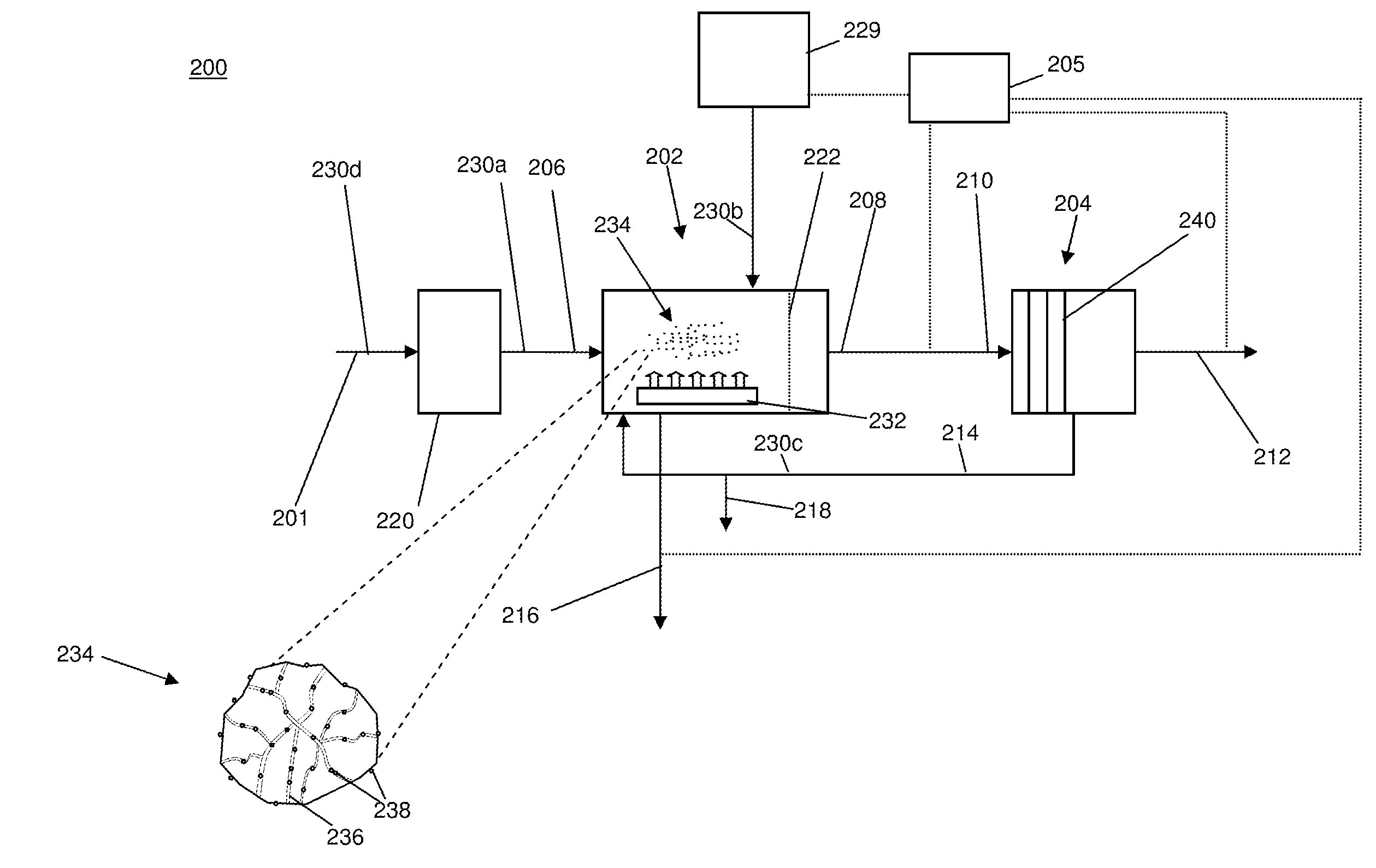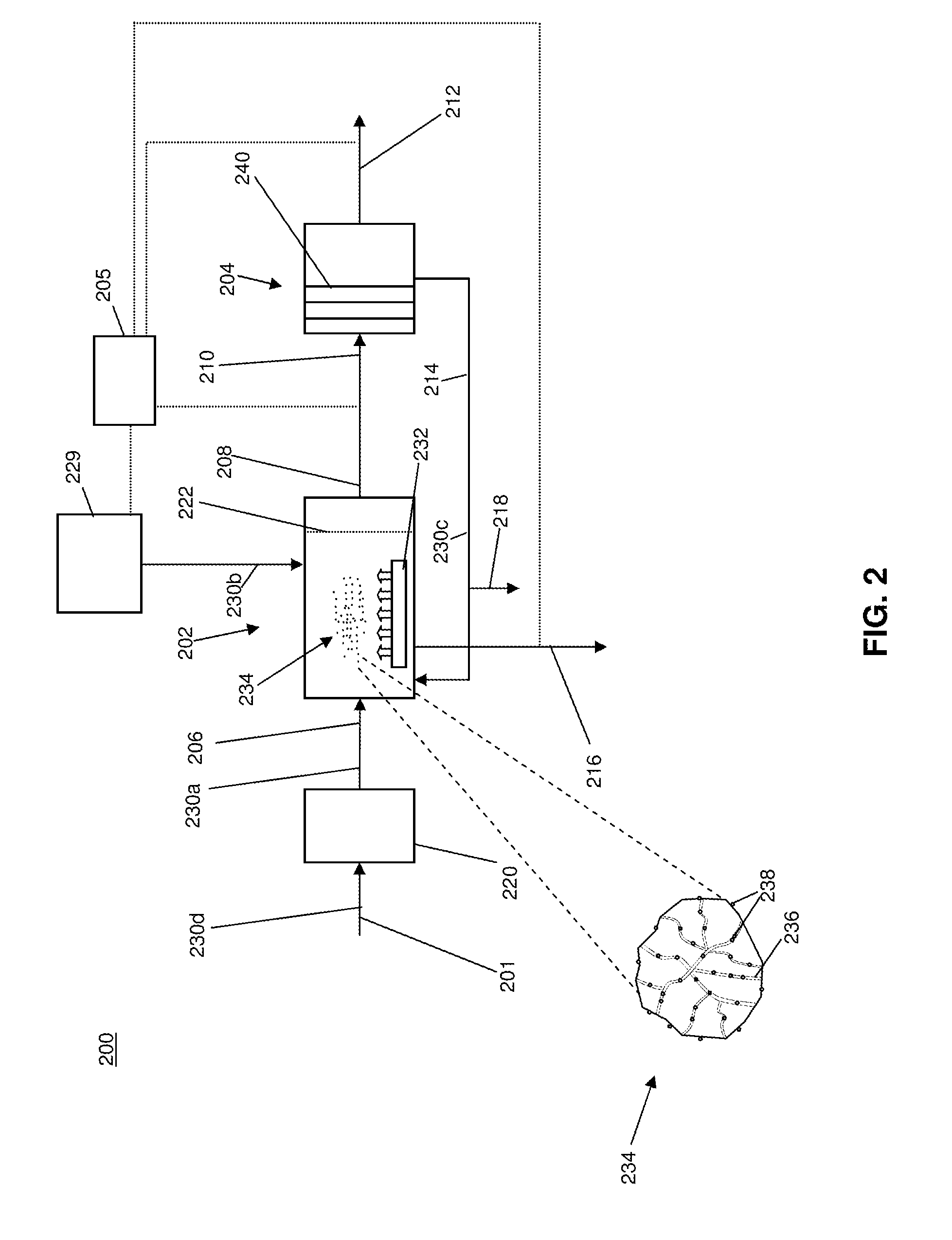Suspended media membrane biological reactor system and process including suspension system and multiple biological reactor zones
a biological reactor and suspension membrane technology, applied in the field of wastewater treatment systems and methods, can solve the problems of hazards for all life forms caused by wastag
- Summary
- Abstract
- Description
- Claims
- Application Information
AI Technical Summary
Benefits of technology
Problems solved by technology
Method used
Image
Examples
example 1
[0192]A pilot scale programmable logic controlled membrane biological reactor system (Petro™ MBR Pilot Unit available from Siemens Water Technologies, Rothschild, Wis., USA) having an aeration tank with an anoxic section, with an capacity of approximately 3,785 liters (1) (1,000 gallons (gal)) and a membrane operating system equivalent to a commercial membrane biological reactor system, was modified to accommodate the granular activated carbon addition described in the present invention. A wedge wire screen was situated at the inlet of a pump that transferred mixed liquor from the aeration tank to the membrane operating system.
[0193]A base synthetic feedstock included water having the following concentrations of organic / inorganic matter: 48 grams per liter (g / l) (48 ounces per cubic foot (oz / cf)) of sodium acetate; 16 g / l (16 oz / cf) of ethylene glycol; 29 g / l (29 oz / cf) of methanol; 1.9 g / l (1.0 oz / cf) of ammonium hydroxide; and 0.89 g / l (0.89 oz / cf) of phosphoric acid. The ammonium...
example 2
[0199]Laboratory particle suspension scale tests were performed using a 2000 milliliter graduated cylinder having a rotameter connected to a source of compressed air and a tube from the outlet of the rotameter to a tube that reached to the bottom of the graduated cylinder. 20 g (0.7 oz) of thoroughly dried granular activated carbon were placed in the cylinder. Room temperature distilled water was also added to the cylinder wetting the particles. The contents of the cylinder were mixed with a spatula to suspend the entire contents and remove air bubbles.
[0200]Air was added to the tube in the cylinder at increasing rates until the first solids were suspended and the air flow was recorded. The airflow was increased until approximately 50% of the solids were suspended (based upon the amount of carbon remaining on the bottom of the cylinder) and the airflow was recorded. Airflow was again increased until all of the granular activated carbon was suspended. The final airflow was recorded. ...
example 3
[0202]A granular activated carbon suspension pilot unit was prepared, utilizing a vertical cylindrical tank having a diameter of 1.83 meters (m) (6 feet (ft)) and a water depth of 2.59 m (8.5 ft). One eductor jet nozzle from Siemens Water Technologies (Rothschild, Wis., USA) was installed through an outer wall of the tank at a distance of 43.5 centimeters (cm) (17.125 inches (in)) from the tank floor. The nozzle, shown in FIG. 15, was directed horizontally towards the center of the tank. A 50 mg / l concentration of granular activated carbon, Mead Westvaco Nuchar WVB14×35 / Wood, was introduced into the tank.
[0203]As depicted in FIG. 15, the jet nozzle system included a jet nozzle 1544 which comprised a fluid inlet 1546, a compressed air inlet 1558 and an outlet 1564. Fluid passed from inlet 1546 to a mixing chamber 1566. Compressed air also entered mixing chamber 1566 where it expanded and imparted energy to the fluid. As the air expanded, the mixture of fluid and air passed to a nozzl...
PUM
| Property | Measurement | Unit |
|---|---|---|
| specific gravity | aaaaa | aaaaa |
| specific gravity | aaaaa | aaaaa |
| specific gravity | aaaaa | aaaaa |
Abstract
Description
Claims
Application Information
 Login to View More
Login to View More - R&D
- Intellectual Property
- Life Sciences
- Materials
- Tech Scout
- Unparalleled Data Quality
- Higher Quality Content
- 60% Fewer Hallucinations
Browse by: Latest US Patents, China's latest patents, Technical Efficacy Thesaurus, Application Domain, Technology Topic, Popular Technical Reports.
© 2025 PatSnap. All rights reserved.Legal|Privacy policy|Modern Slavery Act Transparency Statement|Sitemap|About US| Contact US: help@patsnap.com



